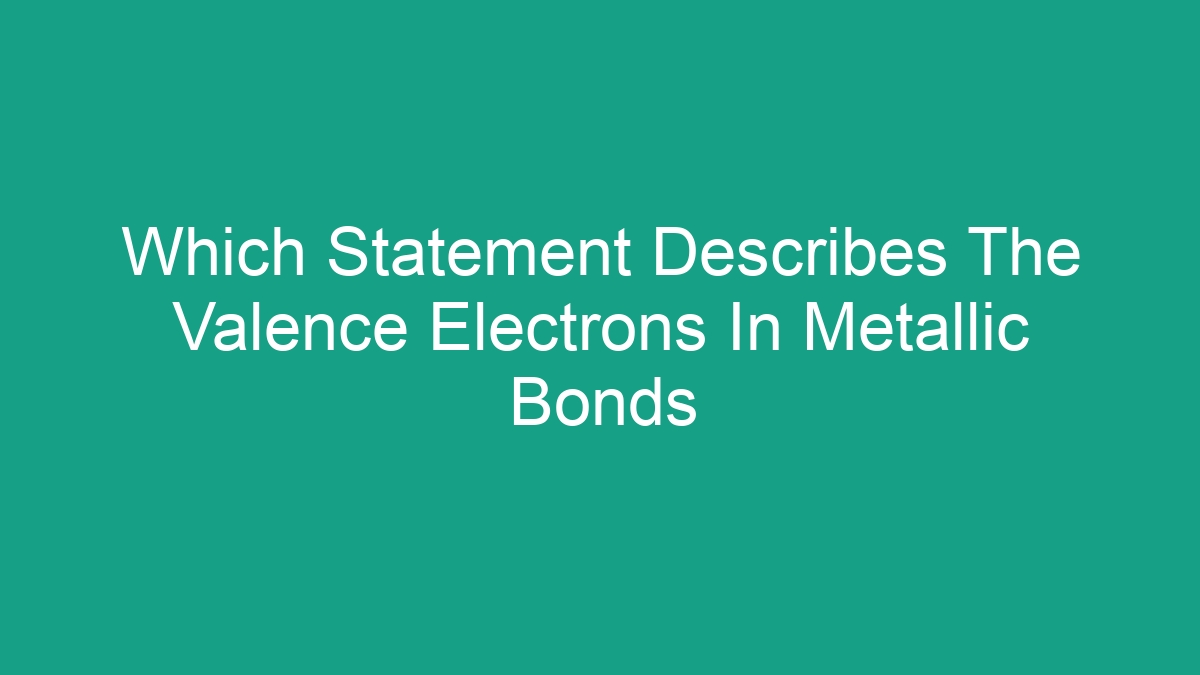
Metallic bonding is a type of chemical bonding that occurs in metals. It is responsible for many of the unique properties of metals, such as their conductivity, malleability, and luster. At the heart of metallic bonding are the valence electrons, which play a crucial role in determining the behavior of metals. In this article, we will explore the nature of valence electrons in metallic bonds and discuss the statements that accurately describe their characteristics.
Understanding Metallic Bonds
Before delving into the role of valence electrons in metallic bonding, it is essential to understand the nature of metallic bonds. In metallic bonding, the atoms of metal elements are held together by a sea of delocalized electrons. Unlike in ionic or covalent bonds, where electrons are localized between specific atoms, in metallic bonding, the outermost electrons of metal atoms are free to move throughout the entire metal structure. This sharing of electrons leads to the formation of a “sea” of electrons that are not bound to any particular atom. The positive metal ions are then held together by the attraction between these ions and the delocalized electrons.
The Role of Valence Electrons in Metallic Bonds
Valence electrons are the electrons in the outermost energy level of an atom. They are involved in chemical bonding and are responsible for the reactivity of an element. In metallic bonding, it is the valence electrons that are free to move throughout the metal lattice, creating a “sea” of mobile electrons. These electrons are not held tightly by any particular nucleus and are able to move freely throughout the metal structure. This mobility of electrons is what gives metals their unique properties, such as high electrical and thermal conductivity, malleability, and ductility.
Statement 1: Valence Electrons in Metallic Bonds Are Delocalized
One of the key statements that accurately describes the nature of valence electrons in metallic bonds is that they are delocalized. This means that the valence electrons are not confined to a specific pair of atoms but are free to move throughout the entire metal lattice. This delocalization of electrons is what allows metals to conduct electricity and heat so effectively. When a potential difference is applied across a metal, the delocalized electrons can flow, creating an electric current. Similarly, the movement of delocalized electrons is responsible for the high thermal conductivity of metals, allowing them to efficiently transfer heat energy.
Statement 2: Valence Electrons in Metallic Bonds Form a Sea of Electrons
Another accurate description of valence electrons in metallic bonds is that they form a “sea” of electrons. This term is often used to visualize the concept of delocalized electrons in metallic bonding. The valence electrons are not attached to any particular nucleus but are shared by all the metal ions in the lattice. This “sea” of electrons is responsible for holding the metal ions together through the mutual attraction between the positive ions and the negative charge of the delocalized electrons. It is this shared pool of electrons that gives metals their characteristic properties, such as malleability and ductility.
Statement 3: Valence Electrons in Metallic Bonds Contribute to Metal’s Shiny Appearance
The high reflectivity and luster of metals can also be attributed to the behavior of valence electrons in metallic bonds. When light strikes a metal surface, the delocalized electrons can interact with the incoming photons, causing them to be absorbed and re-emitted. This interaction between the incoming light and the delocalized electrons results in the characteristic luster and shininess of metals. Additionally, the delocalized electrons can move in response to the incoming light, effectively scattering the photons and creating the reflective surface that we associate with metals.
Statement 4: Valence Electrons in Metallic Bonds Allow for High Ductility and Malleability
Another accurate statement regarding valence electrons in metallic bonds is that they enable metals to have high ductility and malleability. Because the valence electrons are delocalized and able to move freely throughout the metal lattice, the metal ions are able to slide past each other without breaking the metallic bonds. This lends metals their ability to be hammered into thin sheets (malleability) or pulled into thin wires (ductility) without fracturing. The mobility of the delocalized electrons allows the metal ions to adjust their positions without disrupting the overall structure, making metals highly malleable and ductile.
Statement 5: Valence Electrons in Metallic Bonds Contribute to Thermal Stability
Valence electrons also play a role in the thermal stability of metals. The shared pool of delocalized electrons helps to distribute thermal energy throughout the metal lattice. When metals are heated, the delocalized electrons absorb and transfer the thermal energy, preventing localized hotspots and promoting uniform expansion. This thermal stability is crucial in numerous industrial applications, such as in the construction of buildings and the fabrication of machinery, where the ability to withstand temperature variations is essential.
Conclusion
In conclusion, the behavior of valence electrons in metallic bonds plays a crucial role in determining the unique properties of metals. The delocalization of valence electrons creates a “sea” of mobile electrons that contributes to the high electrical and thermal conductivity, luster, ductility, and malleability of metals. Understanding the nature of valence electrons in metallic bonds is essential for comprehending the behavior and applications of metallic materials in various fields, from engineering and manufacturing to electronics and construction. By accurately describing the characteristics of valence electrons in metallic bonds, we gain a deeper insight into the fundamental principles of metallic bonding and its impact on the properties of metals.



